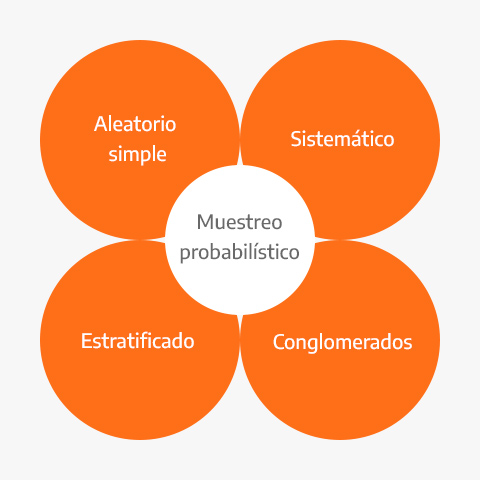Probability sampling
What is probability sampling?
Probability sampling is a type of statistical sample that focuses on analyzing and studying specific groups of a statistical population, using random selection.
Its main requirement is that all people in the population studied have the necessary same selection opportunities.
Types of probability sampling
The probability sampling can be classified into simple, systematic, stratified random sampling and cluster sampling.

Types of probability sampling.
Simple random sampling
Simple random sampling is one of the simplest selection methods for a sample. It is based on randomly choosing the individuals in the sample to be investigated.
To do this, a number is given to each subject in the population and later, as a lottery, numbers are randomly selected to make up the sample.
For example: To take a sample of 10 schools, out of a population of 200 schools in the country, each school obtains a random number. Then, as a raffle, 10 numbers are selected that will make up said sample.
Systematic sampling
Systematic sampling is carried out by dividing the population into subgroups, in the form of a list, to randomly select a number. Then, the chosen number will be, in each group, the individual that makes up the sample.
For example: we have a population of 10,000 people and we must make up a sample of 100 individuals, so the population is divided into 200 groups of 50. Then a random number is selected, for example 20, and thus the sample of 100 individuals is It will be made up of the 20th individual in each group.
Stratified sampling
In stratified sampling, the researcher divides the population into strata or subgroups that generally share certain characteristics. Then, using the simple random sampling method, an individual is chosen from each stratum to make up the sample.
For example: To carry out a research whose population is made up of people who work in a company, the researcher divides said population into the following strata:
- Man with part-time.
- Full-time man.
- Woman with part-time.
- Full-time woman.
Here the researcher is dividing the population into 4 different strata, whose members share characteristics.
Cluster sampling
This method is used when it is not feasible, or impossible, to make an exact list of the elements of a population. To do this, the details of that population must already be grouped into populations, that is, the lists must already exist, or can be created.
For example: A researcher decides to conduct an investigation on Mexico, but dividing the entire population of the country into groups would be difficult and impractical. Therefore, take advantage and use the natural separation by cities. Thus, starting from each city, randomly choose individuals to make up the sample.
Advantages and disadvantages of probability sampling
Probability sampling presents both advantages as disadvantages when investigating.
Advantage
The advantages of probability sampling are as follows:
- It is the easiest way to put together a sample.
- The representativeness increases and it is easier to put into practice.
- It does not require a sampling frame.
- Subpopulations are taken into account and it is accurate.
- It is economical and it is not a problem to carry it out.
Disadvantages
The disadvantages of probability sampling are as follows:
- Sometimes it turns out not very precise and it can be difficult to calculate or interpret your results.
- It is complicated and expensive to choose the stratification variables.
- In some cases it may diminish the aspect of representativeness.
- It is often difficult to specify the sampling frame, as there is less precision.
Examples of probability sampling
Next we propose Some examples To better understand the probability sample:
- To make a sample of 50 employees of a company, which has a total population of 150 employees, use the simple random selection method by choosing, at random, 50 individuals. In this way the sample is formed to carry out the investigation.
- An investigation must be carried out on a certain city, so the researcher divide and list the population into groups of 200 people, then randomly choose the individual number 120 of each group, thus making up the sample.
- At the time of making a population census, a whole population is taken as a sample, where all people have the same possibility of being counted.
Leave a Reply